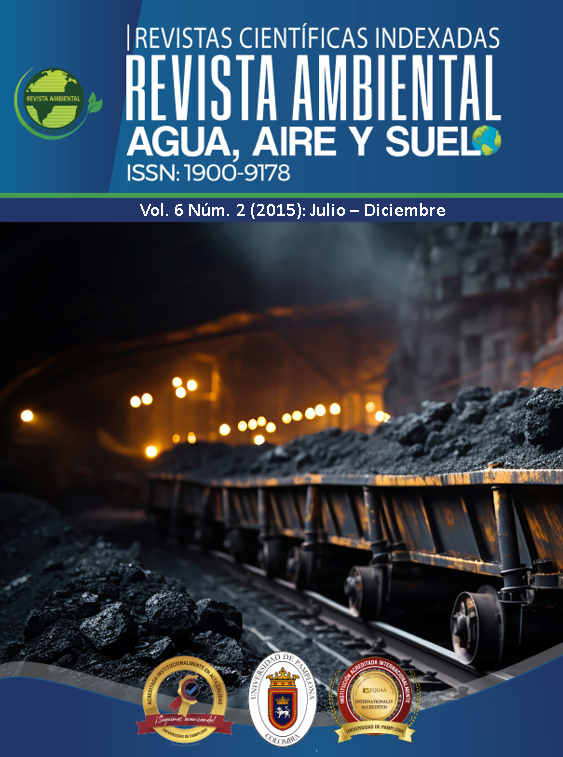Obtaining Native Biodesulfurizing Inocula from High-Sulfur Coals of Norte de Santander
DOI:
https://doi.org/10.24054/aaas.v6i2.780Keywords:
Biodesulfuración, biolixiviación, Biodesulfurization of coal, carbonAbstract
It has been sufficiently demonstrated that the main cause of acid rain is the use of fossil fuels with high sulfur content as an energy source, which release sulfur and nitrogen oxides that react with water and oxygen, forming diluted solutions of sulfuric acid and nitric acid that, when deposited on vegetation cover and soils, cause their deterioration. These effects undeniably exacerbate climate change factors, with the consequent impacts on the environment. The fossil fuel with the largest reserves available to humanity is coal, making it imperative to make efforts to ensure that its use and exploitation cause the least possible negative impact on the environment. It is therefore necessary to make efforts aimed at reducing the sulfur content in coal so that its use as fuel is less polluting. In this project, the growth of bacterial colonies with biodesulfurizing potential will be studied, based on the ability of certain microorganisms to oxidize the reduced sulfur compounds present in coal and convert them into water-soluble products; in general, it is a leaching process using acidulated water with sulfur-reducing microorganisms.
Downloads
References
Vargas, M. J., & Ramón, J. A. (2007). Biodesulfuración de carbón: una alternativa ambientalmente viable en la reducción de azufre del carbón. Revista Ambiental Agua, Aire y Suelo, 2(2), 31-37. ISSN 1900-9178.
Ángel, A., Martínez, O., de Linaje, J. A., Méndez, R., & Morán, A. (2000). Biodesulphurisation of coal by microorganisms isolated from the coal itself. Department of Chemical Engineering, University of León, León, Spain.
Cara, J., Vargas, M., Morán, A., Gómez, E., Martínez, O., & García Frutos, F. J. (2006). Biodesulphurization of a coal by packed-column leaching. Simultaneous thermogravimetric and mass spectrometric analyses. Natural Resources Institute (Chemical Engineering Group), University of Leon, Avda. Portugal 41, 24071 Leon, Spain.
COMISIÓN DE REGULACIÓN DE ENERGÍA Y GAS. Sitio en Internet. Recuperado de: http://www.creg.gov.co. Acceso 12 de mayo de 2003.
DEPARTAMENTO NACIONAL DE PLANEACIÓN. Sitio en Internet. Recuperado de: http://www.dnp.gov.co. Acceso junio de 2014.
ENERGY INFORMATION ADMINISTRATION. (1998). International energy outlook 1998 - 2020. Sitio en Internet. Recuperado de: http://www.eia.org. Acceso mayo de 2015.
PLAN ENERGÉTICO NACIONAL. Participación del Gas Natural y del carbón en la generación térmica. Perspectivas energéticas 1997-2010. UPME.
REVISTA ESCENARIOS Y ESTRATEGIAS. (2000). Carbón mineral: Reactivación del consumo en el interior del país. Unidad de Planeación Minero Energética, N° 6, octubre de 2000, pp. 7-12.
REVISTA ESCENARIOS Y ESTRATEGIAS. (2000). Plan de masificación de gas: Desempeño en la última década. Unidad de Planeación Minero Energética, N° 6, octubre de 2000, pp. 15-25.
UNIDAD DE PLANEACIÓN MINERO ENERGÉTICA. (2000). Futuros para una energía sostenible en Colombia. Bogotá.
UNIDAD DE PLANEACIÓN MINERO ENERGÉTICA. (2001). Plan de expansión de referencia: Generación transmisión, 2001-2015. Bogotá.
UNIDAD DE PLANEACIÓN MINERO ENERGÉTICA. Estadísticas minero energéticas. Sitio en Internet. Recuperado de: http://www.upme.gov.co/estadisticas. Acceso 30 de abril de 2003.
Cara, J. (2000). Tratamiento biológico del carbón en lecho fijo. Modificación de la combustividad. Tesis doctoral. Universidad de Oviedo.
Carranza, M. (1983). Introducción a la lixiviación microbiológica de sulfuros metálicos. Ingeniería Química, Noviembre 83.
Cara, J., et al. (2005). Biodesulphurisation of high sulphur coal by heap leaching. Fuel, 84, 1905-1910.
Pérez, H., & Villa, P. (2004). Desulfuración biológica: Una alternativa para el tratamiento de emisiones de gases a la atmósfera. Agua Latinoamérica, 5(3).
Jensen, A. B., & Webb, C. (1995). Ferrous sulfate oxidation using Thiobacillus ferrooxidans: A review. Process Biochemistry, 30(3), 225-236.
Downloads
Published
Issue
Section
License
Copyright (c) 2021 REVISTA AMBIENTAL AGUA, AIRE Y SUELO

This work is licensed under a Creative Commons Attribution-NonCommercial 4.0 International License.










